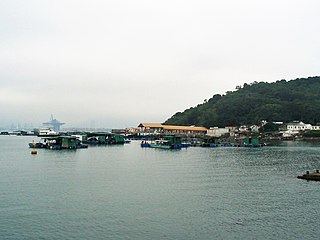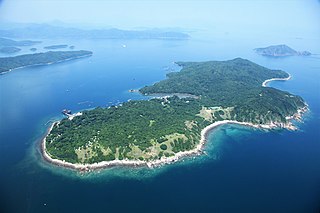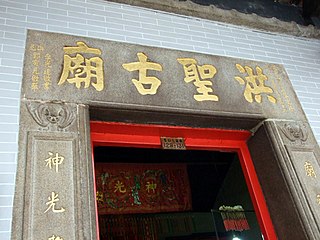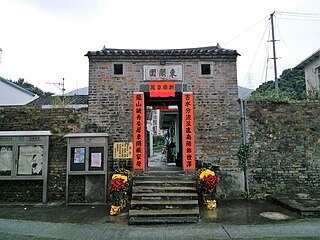
Most of the walled villages of Hong Kong are located in the New Territories.

Kat O also named Crooked Island, is an island in Northeast Hong Kong.

Grass Island or Tap Mun is an island in Hong Kong, located in the northeastern part of the territory. Its area is 1.69 km2 (0.65 sq mi). Administratively, it is part of the Tai Po District. There are about 100 people living on the island, and feral cattle are known on the island.
Declared monuments of Hong Kong are places, structures or buildings legally declared to receive the highest level of protection. In Hong Kong, declaring a monument requires consulting the Antiquities Advisory Board, the approval of the Chief Executive of Hong Kong as well as the publication of the notice on the Hong Kong Government Gazette.

Hung Shing Temples or Tai Wong Temples are temples dedicated to Hung Shing Tai Wong (洪聖大王). Hung Shing temples have been widely built in southern China, especially Guangdong province and in Hong Kong.

St. Joseph's Home for the Aged is located at No. 35 Clear Water Bay Road, Ngau Chi Wan, Wong Tai Sin, New Kowloon, Hong Kong. The site spans 230,000 square feet (21,000 m2).

Queen's Pier, named after Queen Victoria, was a public pier in front of City Hall in Edinburgh Place, Central, Hong Kong. For three generations it served not only as a public pier in day-to-day use but also as a major ceremonial arrival and departure point. The pier witnessed the official arrival in Hong Kong of all of Hong Kong's governors since 1925; Elizabeth II landed there in 1975, as did the Prince and Princess of Wales in 1989.

Victoria Prison, was the first and longest-running prison to date in Hong Kong. It is located on Old Bailey Street in Central, Hong Kong Island. Named in honour of Queen Victoria, it was originally known as Victoria Gaol and was renamed into Victoria Prison in 1899. Victoria Prison has been redeveloped into a cultural and shopping destination generally called Tai Kwun (大館). Tai Kwun is composed of three declared monuments: the former Central Police Station, former Central Magistracy and Victoria Prison.

The Antiquities and Monuments Office (AMO) was established in 1976 under the Antiquities and Monuments Ordinance to protect and preserve Hong Kong's historic monuments. Housed in the Former Kowloon British School, the AMO is responsible for identifying, recording and researching buildings and items of historical interest, as well as organising and coordinating surveys and excavations in areas of archaeological significance. The Commissioner for Heritage's Office under the Development Bureau of the Hong Kong government currently manages the Office.

Hong Kong cultural policy refers to the development and preservation of Hong Kong's arts and cultural heritage. Globally, Hong Kong is perhaps best known for its role as an international financial centre and shopping hub, and not for its artistic and cultural offerings. The popular stereotype of the city holds that its residents are far too focused on getting and spending to concern themselves with the ephemeral affairs of art and culture.

The Antiquities Advisory Board (AAB) is a statutory body of the Hong Kong Special Administrative Region with the responsibility of advising the Antiquities Authority on any matters relating to antiquities and monuments. The AAB was established in 1976 along with the Antiquities and Monuments Office (AMO) when the Antiquities and Monuments Ordinance (Cap. 53) was enacted, and comprises members appointed by the Chief Executive. The corresponding governmental ministry is the Development Bureau, and executive support for the AAB is provided by the AMO which is under the Development Bureau.

Tin Hau temples in Hong Kong are dedicated to Tin Hau (Mazu). Over 100 temples are dedicated to Tin Hau in Hong Kong. A list of these temples can be found below.
The Hong Kong Dragon Garden is an 8 hectares private heritage garden located at No. 32-42 Castle Peak Road, Tsing Lung Tau, in the backdrop of Sham Tseng in the west of the Tsuen Wan District in the New Territories of Hong Kong, founded by Lee Iu-cheung.

The Jamia Mosque is a mosque in Mid-Levels, Hong Kong. The mosque is the oldest mosque in Hong Kong. The neighbouring streets Mosque Street and Mosque Junction are named after this mosque. Mufti Abdul Zaman is the main Imam of this Mosque and he leads prayers and taraweeh in the month of Ramadan.

Marble Hall was the private residence of Sir Catchick Paul Chater, co-founder of Hongkong Land. It was situated at 1 Conduit Road, Hong Kong, and constructed 1901–1904 from imported European marble. Historians regard it as one of the finest ever examples of architecture in Hong Kong.

The Lung Tsun Stone Bridge was a bridge in British Hong Kong which was buried during the construction of Kai Tak Airport and which connected the Kowloon Walled City to a pier leading into Kowloon Bay.

The State Theatre is a former cinema in Hong Kong. It is located in the North Point area along King's Road. Concerns were raised in 2015 that it may be demolished in the near future. The building was listed as a Grade I historic building in March 2017.

Tung Kok Wai, also known as Ling Kok Wai (嶺角圍), is a walled village in Lung Yeuk Tau, Fanling, Hong Kong. It is one of the Five Wai and Six Tsuen (villages) in Lung Yeuk Tau.

Ng Uk Tsuen or Tai Tseng Ng Uk Tsuen (大井吳屋村) is a village in Wang Chau, Yuen Long District, Hong Kong.






















